新人教版高一英语必修一 unit5 听力
- 格式:pptx
- 大小:200.63 KB
- 文档页数:28
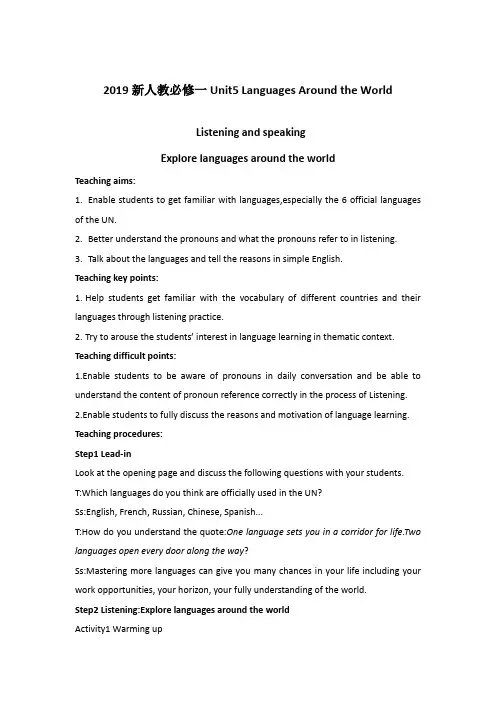
2019新人教必修一Unit5 Languages Around the WorldListening and speakingExplore languages around the worldTeaching aims:1.Enable students to get familiar with languages,especially the 6 official languages of the UN.2.Better understand the pronouns and what the pronouns refer to in listening.3.Talk about the languages and tell the reasons in simple English.Teaching key points:1.Help students get familiar with the vocabulary of different countries and their languages through listening practice.2.Try to arouse the students’ interest in language learning in thematic context. Teaching difficult points:1.Enable students to be aware of pronouns in daily conversation and be able to understand the content of pronoun reference correctly in the process of Listening.2.Enable students to fully discuss the reasons and motivation of language learning. Teaching procedures:Step1 Lead-inLook at the opening page and discuss the following questions with your students. T:Which languages do you think are officially used in the UN?Ss:English, French, Russian, Chinese, Spanish...T:How do you understand the quote:One language sets you in a corridor for life.Two languages open every door along the way?Ss:Mastering more languages can give you many chances in your life including your work opportunities, your horizon, your fully understanding of the world.Step2 Listening:Explore languages around the worldActivity1 Warming upBefore you listen, match each photo with the correct country name. Then discuss which languages are spoken in these countries.(Ex1on page 60) 1 23456 France 3 French Russia 4 Russian Germany 2 GermanSpain 6 Spanish Canada 1 English, French India 5 Hindi, EnglishActivity2: First listeningFor the first listening, you are required to tick the two languages with the most native speakers.Circle the official languages of the United Nations. And then answer the four questions below.1.What is the main topic of this speech?Learning a foreign language.2.How many languages are there in the world?Nearly 7000.3.How many people speak the UN’s official languages as their native or second language?Around 2.8 billion.4.What is the attitude of the speaker towards foreign language learning?It’s very useful to learn one or more foreign languages.Activity3 Second listeningT: Boys and girls, for the second listening, please pay special attention to the pronouns in the speech, especially focus on the italicized words in the sentences below and what they refer to.1.They think it means better job chances in the future.They:students who choose to study a UN language. it: studying a UN language2.They are spoken by around 2.8 billion people.They: the six official UN languages.Activity4 Third listeningListen to the speech for the last time and fill in the blanks with words and phrases you hear(通过最后一遍听力的练习,让学生掌握和熟悉表达态度以及原因的句式,从而为说的练习做好充足的语言支架)To some students,it seems that the only foreign language to learn is English.There are,however,nearly 7,000 languages in the world.After Chinese,the language with the most native language speakers isn’t English—it’s Spanish.Learning English is very useful,but, it is wise to learn at least one other foreign language if possible.There are many reasons why people learn a foreign language.Many students choose to study one of the languages that are spoken at the UN.As they think it means better job chances in the future.The UN has six official languages:Arabic,Chinese,French,Russian,and Spanish.They are spoken by around 2.8 billion people as their native or second language.Some students,though,choose to study a language because of family or friends.One American girl chose to learn Danish because her grandparents were from Denmark.When she was little,her grandpa used to read letters to her in Danish from their relatives in Denmark.Another young lady started learning French because she had several friends from African countries where French is spoken.Step3 Speaking1.Review the listening material and try to complete the table below.(红色部分为学生填写)2.Work in pairs or groups.Discuss which other languages you want to learn and why.(Ex5 on Page61)Example:A:What language do you want to study?B: I really want to study French. I think that the French language sounds beautiful. A:Why? Do you want to go to France some day?B: Yes, I’d love to. Also, French is used by many international organizations around the world. Do you know that FIFA’s full name is in French?A:oh, I remember that. But I don’t know how to pronounce it.Step 4 Homework1.Review the new words learnt from the listening material.2.Tell your partner what language you would love to learn in the future and why.。

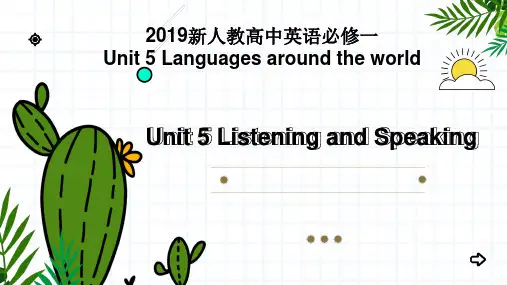
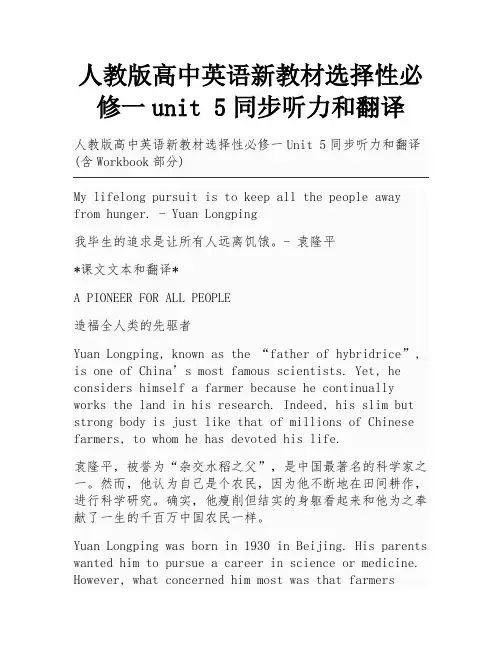
人教版高中英语新教材选择性必修一unit 5同步听力和翻译人教版高中英语新教材选择性必修一Unit 5同步听力和翻译(含Workbook部分)My lifelong pursuit is to keep all the people away from hunger. - Yuan Longping我毕生的追求是让所有人远离饥饿。
- 袁隆平*课文文本和翻译*A PIONEER FOR ALL PEOPLE造福全人类的先驱者Yuan Longping, known as the “father of hybridrice”, is one of China’s most famous scientists. Yet, he considers himself a farmer because he continually works the land in his research. Indeed, his slim but strong body is just like that of millions of Chinese farmers, to whom he has devoted his life.袁隆平,被誉为“杂交水稻之父”,是中国最著名的科学家之一。
然而,他认为自己是个农民,因为他不断地在田间耕作,进行科学研究。
确实,他瘦削但结实的身躯看起来和他为之奉献了一生的千百万中国农民一样。
Yuan Longping was born in 1930 in Beijing. His parents wanted him to pursue a career in science or medicine. However, what concerned him most was that farmersoften had poor harvests and sometimes even had a serious shortage of food to eat. To tackle this crisis, he chose to study agriculture and received aneducation at Southwest Agricultural College in Chongqing.袁隆平1930年出生于北京。


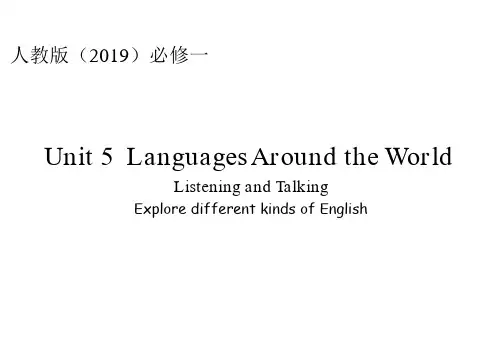

人教版新课标高中一年级(必修一) Unit 5 NelsonMandela—a modern hero第一部分听力(共二节,满分30分)第一节(共5 小题; 每小题1.5 分,满分7.5分)听下面5 段对话,每段对话后有一个小题,从题中所给的A、B、C三个选项中选出最佳选项,并标在试卷的相应位置。
听完每段对话后,你都有10 秒钟的时间来回答有关小题和阅读下一小题。
每段对话仅读一遍。
1. Where does this conversation take place?A. At a hospital.B. At a department store.C. At a restaurant.2. How much is the food and drink?A.$2.65.B. $2.75.C. $2.95.3. What’s the man doing?A. Watching TV.B. Turning down the TV.C. Answering the phone.4. According to the man, what does he like to do if possible?A. To visit museums.B. To make a good plan.C. To visit the Modern Museum.5. What news did the woman get from the man?A. Sam will leave New Y ork very soon.B. Sam’s sister will leave for Los A ngeles very soon.C. Sam’s sister will leave for New Y ork very soon.第二节(共15小题; 每小题1.5分, 满分22.5分)听一下面5段对话或独白。
每段对话或独白后有几个小题, 从每题所给的A、B、C三个选项中选出最佳选项, 并标在试卷的相应位置。


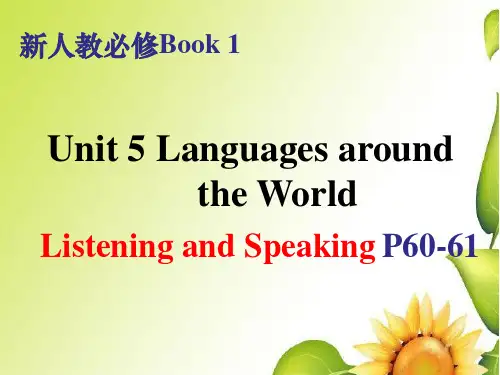
新人教高一英语必修一课本听力与视频材料原文Unit 5Languages Around the WorldListening and SpeakingTo some students, it seems that the only foreign language to learn is English. There are, however, near 7, 000 languages in the world. After Chinese, the language with the most native language speakers isn’t English----it's Spanish! Learning English is very useful, but it is wise to learn at least one other foreign language, if possible.There are many reasons why people learn a foreign language. Many students choose to study one of the languages that are spoken at the UN. As they think it means better job chances in the future. The UN has six official languages: Arabic, Chinese, English, French, Russian, and Spanish. They are spoken by around 2.8 billion people as their native or second languages.Some students, though, choose to study a language because of family or friends. One American girl chose to learn Danish because her grandparents were from Denmark. When she was little, her grandpa used to read letters to her in Danish from their relatives in Denmark. Another young lady started learning French because she had several friends from African countries where French is spoken.What do you think? Which other language would you choose to study and why?Listening and TalkingLISTENNG PART 1As many countries speak English as a first language, there are many different kinds of English around the world: British English, American English, Australian English, and many others. Some English learners might ask, " Can English speakers from different countries all understand each other? " The answer is yes. People in these countries can usually understand each other with very few problems. There are differences in vocabulary, pronunciation, and grammar, but those are usually not big problems. However those differences can cause confusion for non-native English speakers. For example, a student who has learnt British English might not be familiar with the different vocabulary that an American might use. Listen to this conversation between a foreign language student and her American classmateLISTENING PART 2Amy: Thank you very much for helping me with my EnglishBetty:You're welcome! When are you free to meet? This semester, I’m free on Tuesday and Thursday after lunch.Amy: I’m sorry? What does “semester” mean?Betty: You know, semester---- half of a school yearAmy: Oh, you mean like a term?Betty:Yes, like a term. The British say "term". We usually say "semester" here in America.Amy:Got it! My first English lesson with you, haha? OK, let's meet on Tuesday. Where shall we meet?Betty:Let's meet at a coffee shop near my home. It's very convenient to get there by subwayAmy:Subway? Do you mean the Underground?Betty:Yes, the train that goes under the ground!Amy:Ah, got it! Haha, my second English lesson---- thank you!*Video TimeChinese CharactersThe history of Chinese characters dates back to ancient times, with a history of at least several thousand years. There are many tales and legends about the origin of hanzi, Chinese characters: there is Cangjie, the legendary inventor of Chinese characters; the ancient practice of knot-tying: the eight trigrams; and ancient painting legends, to name a few.It is generally agreed that hanzi began as simple pictures, images that the ancient Chinese people drew, painted, or carved to describe nature or their lives. Other ancient cultures developed picture-basedwriting systems as well, such as the hieroglyphs of ancient Egypt or the script of the ancient Mayan civilisation. Hanzi, however, is the only one of these ancient writing systems to survive. Today, Chinese characters are the oldest continuously used system of writing in the world.Researchers generally agree that the oldest symbols recognisable as Chinese characters are those found on ancient oracle bones. These 3000-year-old symbols, known as jiaguwen, were carved on turtle shells or bones of animals. The jiaguwen can give all of us in the modern era insight into how ancient Chinese saw the world around them and into their great creativity in expressing their observations.Take, for example, the modern character jia, meaning home or family. The jiaguwen character looks like a house with a nice pig inside, originating from the ancient idea that a good family home has plenty food. Over thousands of years, this hanzi evolved into a variety of different forms but finally developed in a more stable manner after the unification of China under Emperor Qinshihuang.When you first look at Chinese characters, you will most likely feel that they are very complicated However, if you know just a little about how these characters are formed, you will find that they are not nearly as difficult as they seem. About 80% of Chinese characters are composed of smaller parts, known as radicals, which are combined in many different ways to form tens of thousands of hanzi. Fortunately you need to knowonly about two or three thousand characters for use in daily life.Chinese characters and Chinese culture are inseparably linked. China's unified writing system forms a strong bridge linking the Chinese people and culture of the present with those of the past. No matter when or where you live, if you can read Chinese, you can read ancient Chinese classics. It is truly an amazing thing to be able to hear the thoughts and observations of people from thousands of years ago.As China takes its place in the international community, the Chinese writing system has spread to other countries. Today, many international students are studying Chinese, both the spoken and written language, and are coming to appreciate Chinas fascinating culture. And, as China’s culture and society have continued to develop, the amazingly versatile Chinese characters (hanzi) have been adapted for use in digital format on computers and other devices And so written Chinese lives on, spreading Chinese culture wherever It goes.。